Please click here to access the main AHDB website and other sectors.
- Home
- Knowledge library
- Recognition and biology of the main thrips species damaging protected ornamentals
Recognition and biology of the main thrips species damaging protected ornamentals
Learn to identify the main species of thrips that can damage protected ornamentals and gain key information about their biology.
Back to: Thrips control in protected ornamental crops
Native or established thrips species
Although expert microscopic examination is needed to confirm the exact thrips species, certain features such as colour of the adults or larvae can help in recognition. Western flower thrips (WFT) is described in detail and other relevant species are described briefly to help to distinguish them from WFT. Relevant information is also given on biology and behaviour, as this knowledge helps to plan control strategies.
Western flower thrips
Western flower thrips (WFT) (Franklinella occidentalis) were introduced to the UK on infested plant material in 1986 and since then has become widely established, mainly on protected crops, but also on some outdoor crops such as strawberry. Western flower thrips are no longer a notifiable, quarantine pest in the UK.
Host plants
Western flower thrips are a major pest of many protected ornamental and edible crops. Common flowering bedding and pot plant hosts include: Brachycome, Chrysanthemum, Cineraria, Cyclamen, Dahlia, Fuchsia, Impatiens, ivy-leaf geranium, Primula and Verbena. Cut flower hosts include: Alstromeria, Chrysanthemum, Dahlia, Gerbera and Lisianthus. Foliage plant hosts include: Ficus, Maranta, palms and Radimachera. Weed hosts include: chickweed, dandelion, groundsel, sowthistle, woody and black nightshade.
Adults
Like other thrips species, WFT adults are small, slim insects, with narrow wings fringed with hairs. Female WFT are slightly larger (1.5–2 mm long) and darker than the males. The females usually have a yellowish head and front half of the body and a brownish back half, although colour can be variable. The males are yellowish all over. Adults can be found on upper or lower leaf surfaces but prefer to feed in flowers or buds if present. Adults can live for several weeks. On Chrysanthemum, they live for about 75 days at 20°C and 31 days at 25°C. The temperature ‘threshold’ for flight is 20°C but they can be active and lay eggs at lower temperatures.
Western flower thrips (Frankliniella occidentalis) adult female with yellowish front end and darker hind end
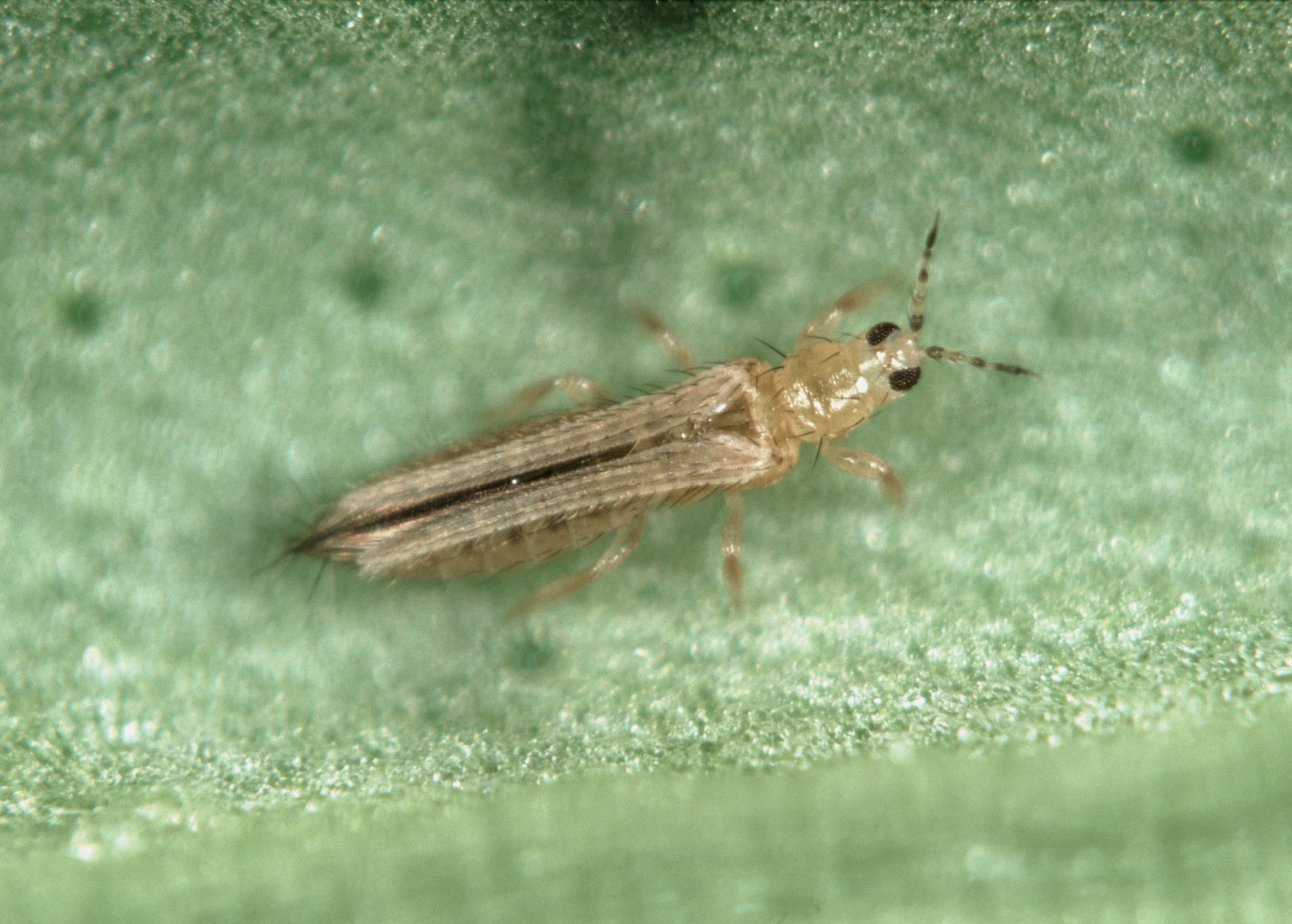
Image © Nigel Cattlin.
Eggs
Like those of other thrips species, WFT eggs are not visible as the females lay them into plant tissue.
Larvae
Western flower thrips larvae hatch from the eggs after a few days, depending on temperature. The development rate varies with host plant and temperature. On Chrysanthemum, at fluctuating summer temperatures of 18°C night and 36°C day, they hatch after three days. There are two larval stages (instars), neither of which have wings. First instar larvae are less than 1 mm long and they are colourless or white. They feed for two or three days before developing into the second instar larvae which are about 1 mm long and yellow. On Chrysanthemum, the second instar lasts for about 10 days at 20°C and five days at 25°C, but develops more slowly at lower temperatures. When fully grown, most of the second instar larvae drop from the plants to pupate in the ground, growing media or substrate. However, a small proportion may pupate on the plants, in sheltered places such as on the underside of lower leaves, or hidden in flowers. Pupation on the plant occurs more frequently in very high relative humidities than in drier conditions.
Western flower thrips yellow second instar larva
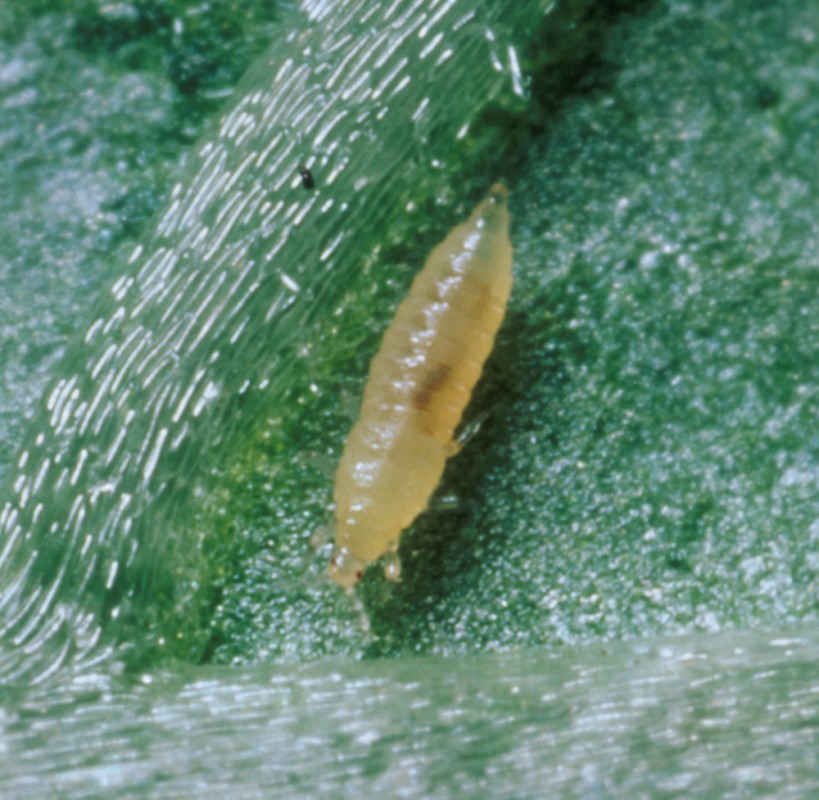
Image © ADAS Horticulture.
Pupae
Like other thrips species, WFT has two pupal stages, the prepupa and the pupa, neither of which feed. Both these stages are yellowish and about 2 mm long. The prepupa has short immature wings and short, forward-pointing antennae. The prepupal stage lasts only for a day or two then it develops into the pupa which has longer immature wings and longer antennae which fold backwards over the body. The pupal stage lasts for about five days at 20°C and three days at 25°C. When pupation is complete, the new adult thrips emerges from the pupal case.
Western flower thrips pupa with backward pointing antennae and long immature wings
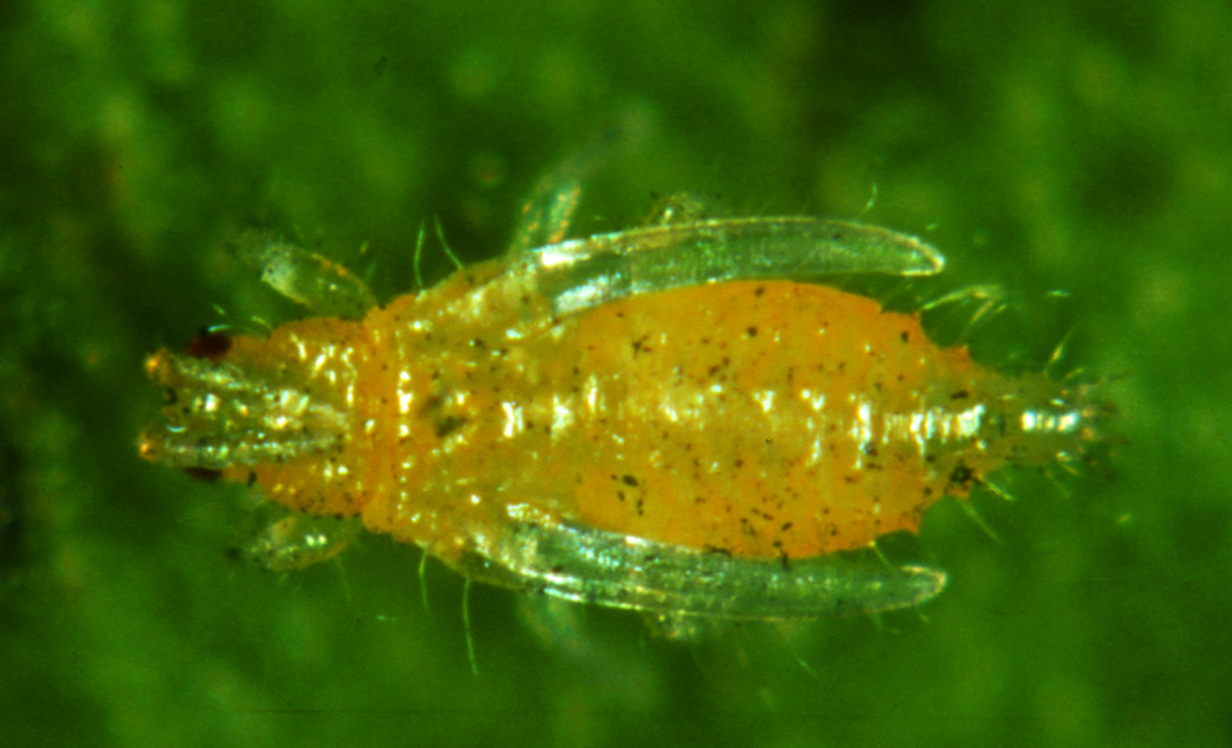
Image © Nigel Cattlin.
WFT development and survival
Western flower thrips are more of a problem in warmer temperatures between spring and autumn, but breeding can continue all year on host plants in heated glasshouses. Western flower thrips can develop slowly below 10°C, but most information on development rates has been obtained between 10°C and 35°C. Adult females can survive over the winter outdoors or in unheated structures in soil, on plants or on plant debris, becoming active and feeding on warmer days. At a typical summer glasshouse with fluctuating temperatures of 18°C night, 36°C day, WFT can develop from egg to adult in only 11 days on Chrysanthemum. The pest can therefore breed very quickly during the summer and can complete many generations per year, particularly in heated structures.
Other thrips species
The onion thrips is native to the UK. It is a common pest of outdoor vegetable crops such as onion and leek, in addition to many protected edible and ornamental crops. Although WFT is now the predominant species on protected crops, onion thrips can still be found. Bedding, pot plants and cut flower hosts are the same as those listed for WFT. Onion thrips has also been recorded damaging poinsettia in the UK in glasshouses with nearby onion or leek crops.
Life stages
Onion thrips can look very similar to WFT. In the UK, the adults are all female and vary in colour from greyish yellow to brown. First instar larvae are colourless or white. Second instar larvae tend to be greenish, rather than yellow as in WFT. Adults and larvae feed on leaves and in flowers. The older larvae drop to the ground to pupate.

Image © Nigel Cattlin.
This species is alien to the UK, but it is not currently classed as a notifiable quarantine species. Japanese flower thrips is native to South East Asia and has recently spread to some Northern European countries. It was first found in the Netherlands in 2014, on both protected and outdoor Hydrangea and was first detected in the UK in 2016 on poinsettia.
Host plants
Japanese flower thrips will feed on many different ornamental and edible plant species, recorded ornamental host plants include: Abelia, Aster, Begonia, Chrysanthemum, Cyclamen, Dahlia, Gerbera, Hippeastrum, Hosta, Hydrangea, lily, poinsettia, primrose, rose, Saintpaulia, Sparmannia, Streptocarpus, and Tagetes. In the UK, particular problems have occurred on Cyclamen, New Guinea Impatiens and some herb crops including basil and rosemary. On some crops in the Netherlands, such as poinsettia and Saintpaulia, adults have been found but no larvae, indicating that they do not lay eggs and breed on these plants.
Life stages
The adult females are approximately 1.3 mm long, dark brown with pale patches at the base of the wings. Males, like those of WFT, are yellow but the paler patches at the base of the wings are still visible. The first instar larvae are white and smaller than the second instar larvae which can be white or yellowish depending on what they have fed on. A laboratory study indicated that the second instar larvae drop to the ground to pupate.

Image © Dr Manfred Ultitzka.
This species is not native to the UK, but it is not a notifiable quarantine pest. It was first confirmed in the UK in 1995, on Syngonium imported from the Netherlands. Since then, it has spread to many countries via plant trade. Recorded ornamental host plants include: Chrysanthemum, Dieffenbachia, Fatsia, Ficus, Gerbera, Hibiscus, Impatiens, Philodendron, poinsettia, rose and Spathiphyllum.
Life stages
Adult poinsettia thrips are slightly larger than those of WFT. The adults are dark brown to black, with yellow ‘feet’ and distinctive pale areas at the bases of the wings, giving the thrips the appearance of having pale ‘shoulders’. The larvae and pupae are whitish yellow and paler than those of WFT or onion thrips. Both adults and larvae live on the leaves rather than in flowers. Unlike WFT or onion thrips, poinsettia thrips larvae always pupate on the leaves rather than dropping to the ground to pupate.
Poinsettia or impatiens thrips (Echinothrips americanus) adult with brown/black body, pale wing bases and yellow ‘feet’

Image © Fera Science Ltd.
Poinsettia or impatiens thrips pupa on leaf with pale body and immature wings
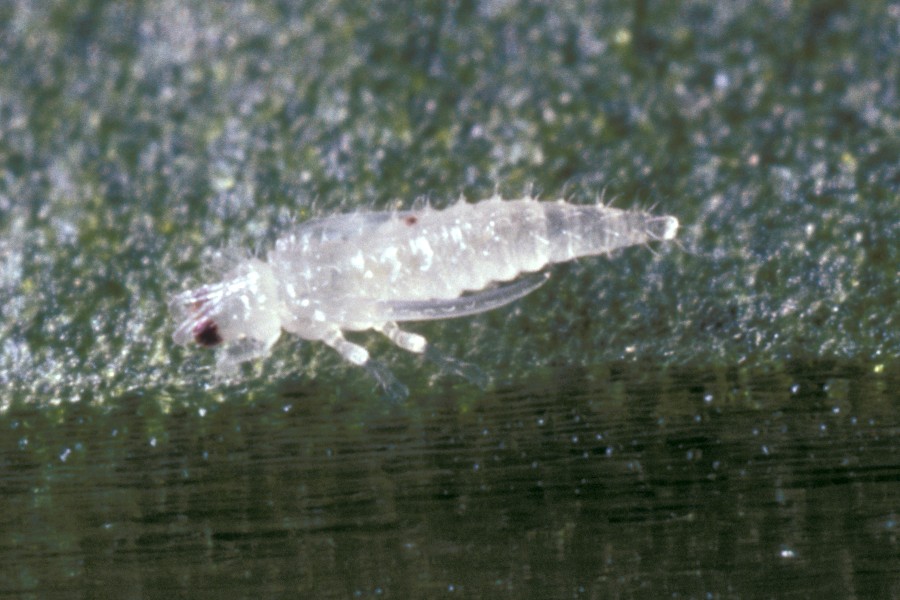
Image © Fera Science Ltd.
This species, also known as the palm thrips is not native to the UK, but it is not a notifiable quarantine pest. It is established in glasshouses and in internal landscaping and can occur on foliage plants including citrus, Ficus, kentia palm, Stephanotis and Tradescantia. The adults are brown with yellow ‘feet’ and have pale wings with dark bands across them, giving a striped appearance. The larvae are white and translucent.
This originally tropical species is also established under glass in the UK. It is not a notifiable quarantine pest. It feeds mainly on foliage and pot plant hosts including orchids and palms and it has also been found on some ferns. The pest has also been recorded on Begonia, Chrysanthemum and Fuchsia but it is not a common pest of these plants in the UK. The adults are dark brown to black, sometimes with an orange-yellow tip to the abdomen and pale yellow antennae, legs and wings. The larvae are pale and often have a large round droplet of reddish or black fluid at the end of the body, which drops onto the leaf and can lead to the growth of sooty moulds.
This species is also native to South East Asia and has spread to Europe via plant trade. It is not a notifiable quarantine species in the UK. Vanda thrips feeds and breeds on various orchids including Arundina, Cattleya, Dendrobium, Phalaenopsis and Vanda species. The adult females are 1–1.2 mm long, dark brown or black with white patches at the base of the wings and the second instar larvae are yellow.
Vanda thrips (Dichromothrips corbetti) adult female with dark brown/black body and pale wing bases
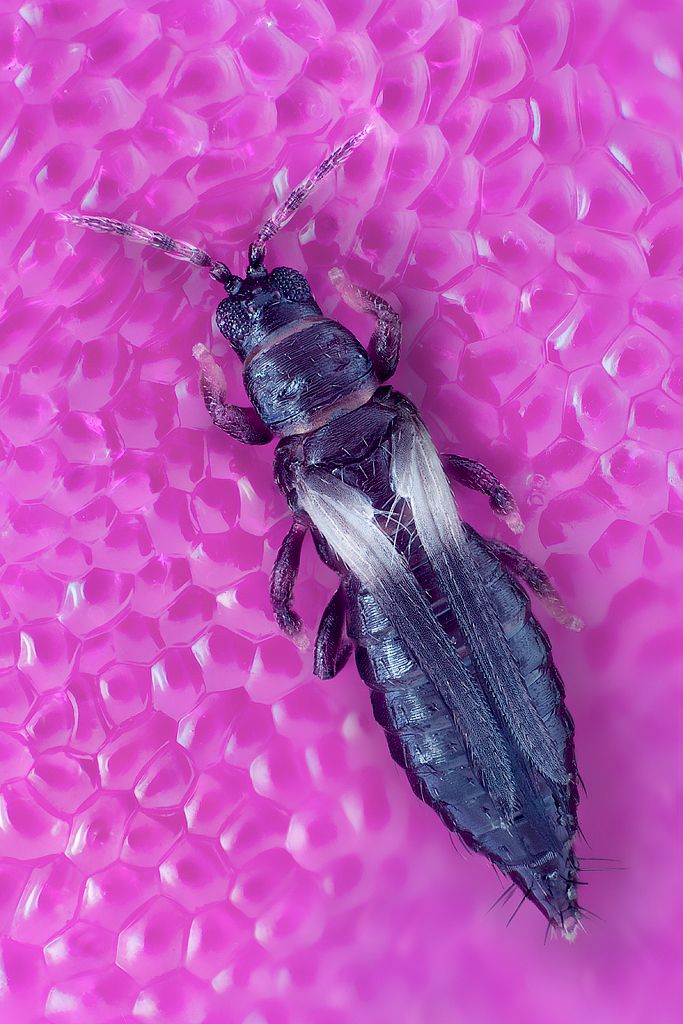
Image © Dr Manfred Ultitzka.
Grain or cereal thrips (such as Limothrips cerealium) often fly into glasshouses during the summer, particularly during harvesting of nearby cereal crops. They are commonly known as ‘thunderflies’ or ‘thunderbugs’ as they take flight in large numbers in warm, humid conditions. The adults are dark brown or black and easily distinguished from WFT or onion thrips on sticky traps. Grain thrips do not breed on bedding, pot plant or flower crops so larvae are not seen on these plants.
Grain thrips (Limothrips species) with brown/black body on yellow sticky trap
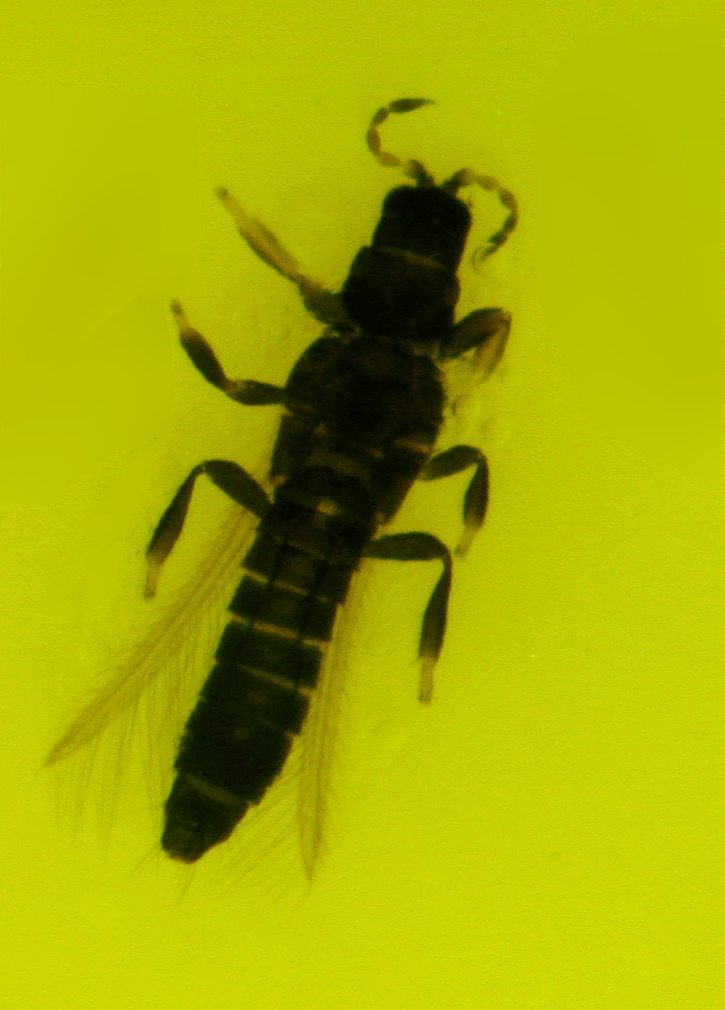
Image © ADAS Horticulture.
Quarantine thrips species
The following two thrips species are not native to the UK and are quarantine pests, notifiable to your local APHA Plant Health and Seeds Inspector whenever found or suspected.
Melon thrips (Thrips palmi)
Melon thrips is a serious pest in Asia and parts of Australasia, the USA, the Caribbean, South America and Africa. The pest has a wide host range, infesting both edible and ornamental plants, including: Chrysanthemum, Cyclamen, Ficus, Helianthus and orchids. So far there has been only one outbreak in the UK, on Chrysanthemum, which was successfully eradicated in 2001. However, APHA has regularly intercepted the pest on various plants and produce and there is a continued risk of importing it on cuttings and plant material. The adults are small and yellow, about 1-1.3 mm long. The larvae are creamy yellow and usually drop to the ground to pupate, although occasionally pupae can be found on the plants. Melon thrips do not disperse well and it is likely to be spread on infested plant material rather than by adult flight. At 25°C the life cycle is completed in around 17.5 days. The pest is unlikely to survive the UK winter outdoors.
Melon thrips (Thrips palmi) adult with yellow body
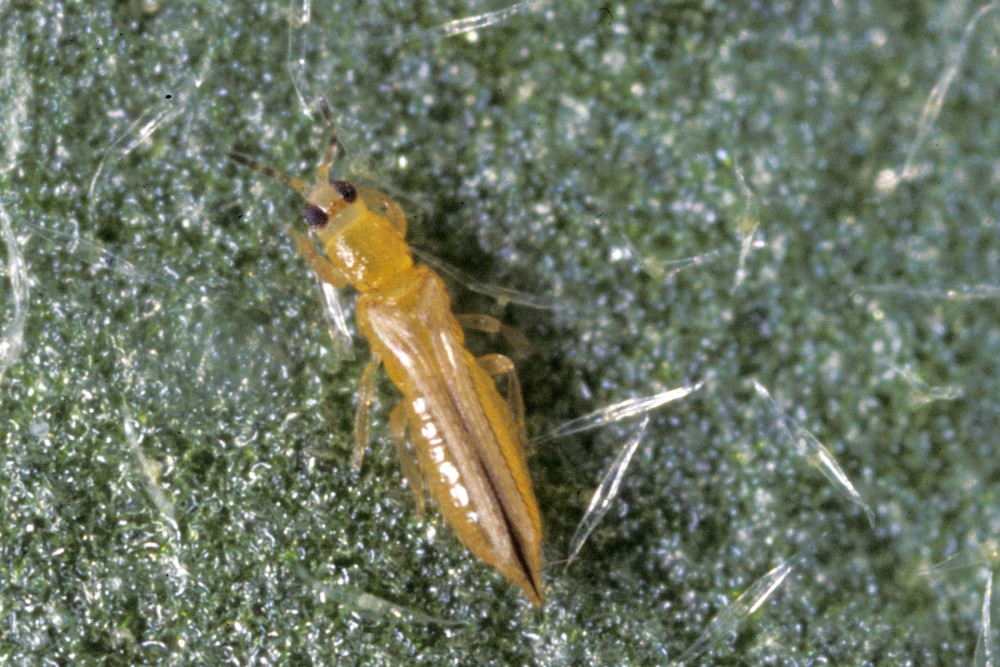
Image © Fera Science Ltd.
Chilli thrips (Scirtothrips dorsalis)
The chilli thrips or yellow tea thrips has not been detected in UK nurseries, but an outbreak occurred under glass in a botanical garden in the south of England which was eradicated in 2019. The pest is native to Asia but in recent years has started to spread rapidly across the world, including to Africa, Israel, the Caribbean and North and South America. APHA has regularly intercepted the pest since 2005 on produce from India, Kenya, St. Lucia and Thailand. Chilli thrips has a wide host range including both edible and ornamental plants such as Chrysanthemum, Dahlia, Hydrangea and rose. The adults are small, only about 1 mm long, with pale yellow bodies and wings that appear dark when at rest against the body.
Chilli thrips (Scirtothrips dorsalis) adult
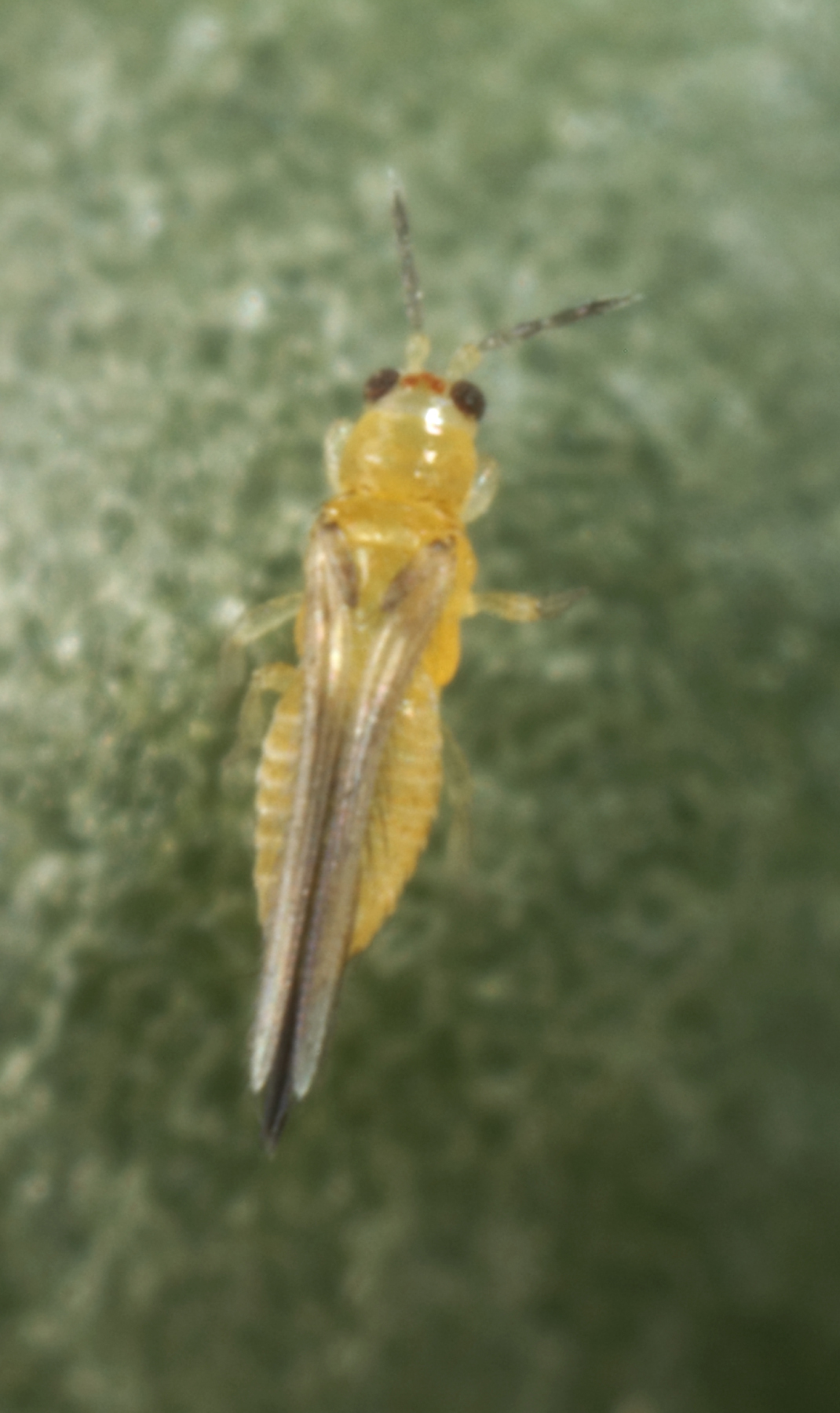
Image © Fera Science Ltd.
Useful links
For further help with thrips identification, images of many of the pest thrips can be found in the ‘Knowing and recognising thrips in crops’ poster.
Knowing and recognising thrips in crops
Read the AHDB review on ‘new’ thrips problems in protected ornamentals and herbs for more information on Thrips setosus and Dichromothrips corbetti.
For more information on Thrips palmi read the Defra Plant Pest factsheet.
Authors
Jude Bennison, ADAS Horticulture.
Got a question? Ask a member of the team:
Web page content correct as of May 2021.
Topics:
Sectors:
Tags:

